Fram
Fram ("Forward") is a ship that was used in expeditions of the Arctic and Antarctic regions by the Norwegian explorers Fridtjof Nansen, Otto Sverdrup, Oscar Wisting, and Roald Amundsen between 1893 and 1912. It was designed and built by the Scottish-Norwegian shipwright Colin Archer for Fridtjof Nansen's 1893 Arctic expedition in which the plan was to freeze Fram into the Arctic ice sheet and float with it over the North Pole.
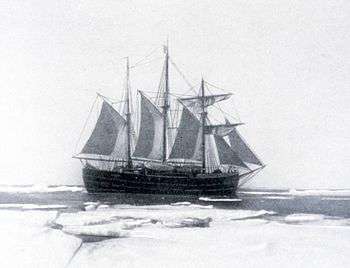 Fram in Antarctica during Roald Amundsen's expedition | |
| History | |
|---|---|
| Name: | Fram |
| Builder: | Colin Archer, Larvik, Norway |
| Launched: | 1892 |
| In service: | 1893 |
| Out of service: | 1912 |
| Fate: | Preserved; on display at the Fram Museum, Oslo |
| General characteristics | |
| Type: | Schooner |
| Tonnage: | 402 grt[1] |
| Length: | 127 ft 8 in (38.9 m) |
| Beam: | 34 ft (10.36 m) |
| Draft: | 15 ft (4.57 m) |
| Propulsion: |
|
| Speed: | 7 knots (13 km/h; 8.1 mph) |
| Complement: | 16 |
Fram is said to have sailed farther north (85°57'N) and farther south (78°41'S) than any other wooden ship. Fram is preserved at the Fram Museum in Oslo, Norway.
Construction
Nansen's ambition was to explore the Arctic farther north than anyone else. To do that, he would have to deal with a problem that many sailing on the polar ocean had encountered before him: the freezing ice could crush a ship. Nansen's idea was to build a ship that could survive the pressure, not by pure strength, but because it would be of a shape designed to let the ice push the ship up, so it would "float" on top of the ice.

Fram is a three-masted schooner with a total length of 39 meters and width of 11 meters. The ship is both unusually wide and unusually shallow in order to better withstand the forces of pressing ice.
Nansen commissioned the shipwright Colin Archer from Larvik to construct a vessel with these characteristics. Fram was built with an outer layer of greenheart wood to withstand the ice and with almost no keel to handle the shallow waters Nansen expected to encounter. The rudder and propeller were designed to be retracted. The ship was also carefully insulated to allow the crew to live on board for up to five years. The ship also included a windmill, which ran a generator to provide electric power for lighting by electric arc lamps.[2]
Initially, Fram was fitted with a steam engine. Prior to Amundsen's expedition to the South Pole in 1910, the engine was replaced with a diesel engine, a first for polar exploration vessels.
Expeditions
Fram was used in several expeditions:
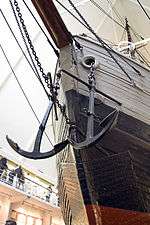
Nansen's 1893–1896 Arctic expedition
Wreckage found at Greenland from USS Jeannette, which was lost off Siberia, and driftwood found in the regions of Svalbard and Greenland, suggested that an ocean current flowed beneath the Arctic ice sheet from east to west, bringing driftwood from the Siberian region to Svalbard and further west. Nansen had Fram built in order to explore this theory.
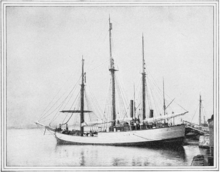
He undertook an expedition that came to last three years. When Nansen realised that Fram would not reach the North Pole directly by the force of the current, he and Hjalmar Johansen set out to reach it on skis. After reaching 86° 14' north, he had to turn back to spend the winter at Franz Joseph Land. Nansen and Johansen survived on walrus and polar bear meat and blubber. Finally meeting British explorers, the Jackson-Harmsworth Expedition, they arrived back in Norway only days before the Fram also returned there. The ship had spent nearly three years trapped in the ice, reaching 85° 57' N.[4]
Sverdrup's 1898–1902 Canadian Arctic islands expedition
In 1898, Otto Sverdrup, who had brought Fram back on the first Arctic voyage, led a scientific expedition to the Canadian Arctic Archipelago. Fram was slightly modified for this journey, its freeboard being increased. Fram left harbour on 24 June 1898, with 17 men on board. Their aim was to chart the lands of the Arctic Islands, and to sample the geology, flora and fauna. The expeditions lasted till 1902, leading to charts covering 260,000 km2, more than any other Arctic expedition.[5]
Amundsen's 1910–1912 South Pole expedition

Fram was used by Roald Amundsen in his southern polar expedition from 1910 to 1912, the first to reach the South Pole, during which Fram reached 78° 41' S.
Preservation of Fram
The ship was left to decay in storage from 1912 until the late 1920s, when Lars Christensen, Otto Sverdrup and Oscar Wisting initiated efforts to preserve her. In 1935, the ship was installed in the Fram Museum, where she now stands.
Named after Fram
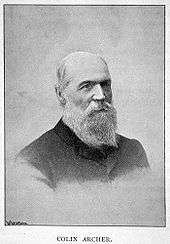
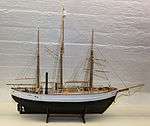
- Fram Island (Ostrov Frama), an island close to the Komsomolskaya Pravda Islands, Laptev Sea
- Framheim (literally "Home of the Fram"), Amundsen's Base at the Bay of Whales in Antarctica during his quest for the South Pole
- Fram Rupes, an escarpment on Mercury
- Fram crater, a small crater on Mars, visited by the Mars Exploration Rover Opportunity in 2004
- Fram Basin, the deepest point in the Arctic Ocean
- Fram Strait, a passage from the Arctic Ocean to the Greenland Sea and Norwegian Sea, between Greenland and Spitsbergen.
- Fram, a play by Tony Harrison, premièred at the National Theatre London, 2008
- In Arthur Ransome's children's book, Winter Holiday, the children use the name Fram for their Uncle Jim's houseboat, trapped in the ice on the lake which becomes the inspiration for some of their adventures.
- The Adventures of Fram, the Polar Bear (Romanian: Aventurile lui Fram, ursul polar), a children's book written by the Romanian author Cezar Petrescu which was also made into a TV series in Romania;
References
- Amundsen, Roald, The South Pole; an Account of the Norwegian Antarctic Expedition in the Fram, 1910–12, Volume 2, Appendix I, "The Fram" (1912). Translated by Sydpolen.
- Nansen, Fridtjof (1897). "ch 2". Farthest North, Volumes I and II. London: Archibald Constable & Co.
- Wikisource:Popular Science Monthly/Volume 57/August 1900/The Evolution and Present Status of the Automobile
- Apsley Cherry-Garrard, The Worst Journey in the World, Carroll & Graf Publishers, 1922, p. xxii
- Gerard Kenney Ships of Wood and Men of Iron: A Norwegian-Canadian Saga of Exploration in the High Arctic, ISBN 0-88977-168-5, 1984